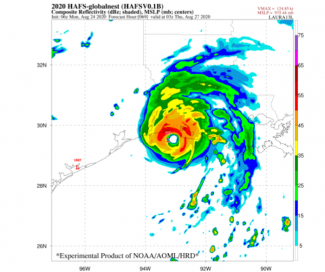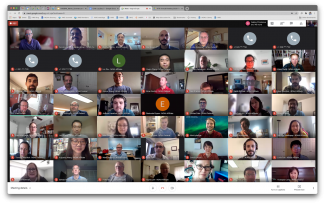The three-day HFIP Annual Meeting 2020 was held virtually on November 17-19, 2020. Approximately 130 participants from NOAA line offices, DTC, NCAR, and university partners participated in the meeting. NOAA/NWS/OSTI Modeling Program Division Director Dr. Dorothy Koch kicked off the meeting with welcoming remarks. Day one focused on HFIP programmatic updates, a discussion of forecasters' needs and current activities supporting operations and a summary of the results from the forecasters' HFIP display survey. Day two consisted of a review of the current state of operational modeling capabilities and results from the 2020 hurricane season real-time experiments, as well as a special panel discussion on the operational modeling challenges faced by both forecasters and the developers that was helmed by panelists from the UK Met Office and ECMWF. The final day opened with updates on the HFIP-funded external research, followed by discussions on the development of the next-generation Hurricane Analysis and Forecast System (HAFS). As is evident from the Agenda, each day was tightly packed with engaging presentations that represented the diverse interests of the field. NOAA/AOML Hurricane Research Division Director Dr. Frank Marks concluded the meeting with a summary and recommendations.
The primary objective of this meeting was to assess the progress made and challenges identified in achieving the HFIP goals, as documented in the 2019 HFIP Strategic plan. This plan was developed under the Weather Research and Forecasting Innovation Act, Section 4. To meet the plan’s objectives, six key strategies were developed: 1) advance the operational HAFS; 2) improve probabilistic guidance; 3) enhance communication of risk and uncertainty; 4) support dedicated high-performance computing allocation; 5) R2O enhancement; and 6) broaden expertise and expand interaction with the external community.
Throughout the meeting, each key strategy's many successes were enumerated. The 2020 hurricane season marked the second year of successful real-time HAFS testing with four different HAFS model configurations. Improvements in graphical products, tropical roadmap, eight to nine ongoing social and behavioral science projects, and AWIPS/ATCF improvements attributed to the success of the HFIP strategies. As for computation efforts, 60M h/month is dedicated for development, testing, and evaluation of HAFS. The HFIP continues to foster the external university partners by funding three research proposals in 2020.
To address the implementation of HAFS, which is planned for 2022, the meeting convened a discussion of the design and testing of potential 2021 HAFS configurations that could run within the operational HPC resources. The HAFS session attendees recommended maintaining real-time test capability on Research and Development High-Performance Computing(RDHPC) systems(Jet, Hera, & Orion) to test the potential configuration. Other recommendations offered during the meeting included performing an evaluation of 2020 operational problem cases, evaluation of observational impact, evaluation of and improvements to the wind radii metrics, and data display capacity on AWIPS II.

